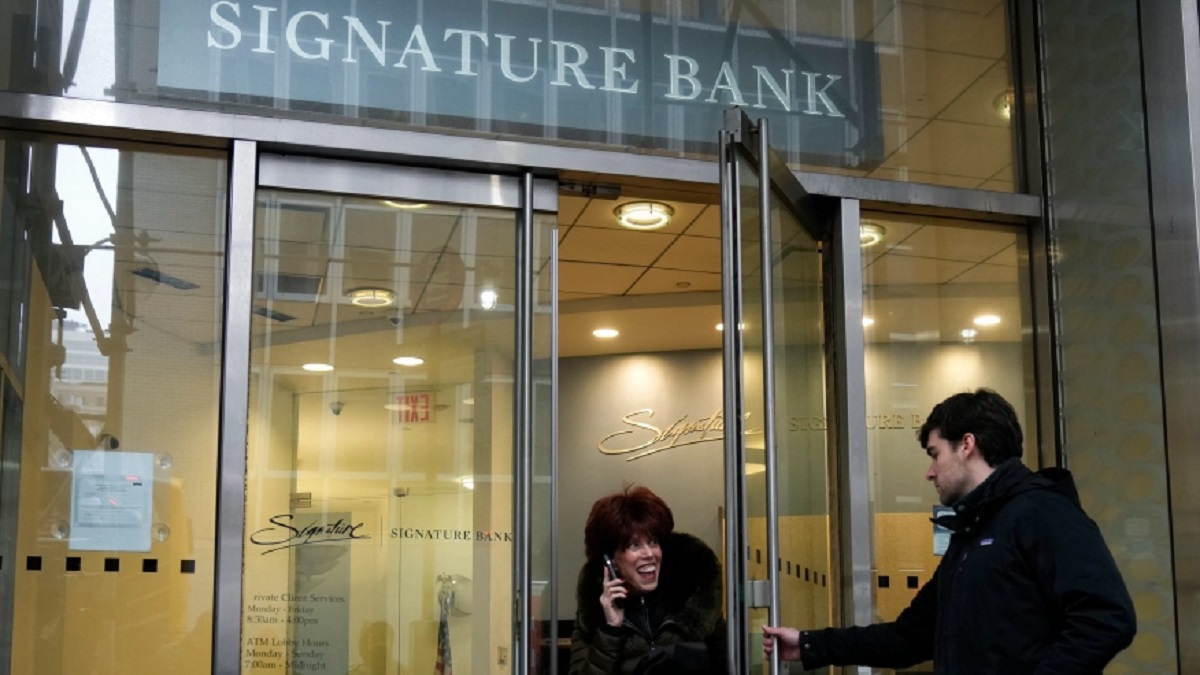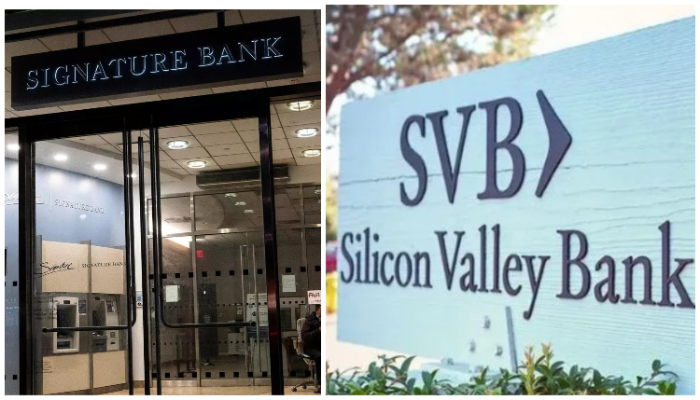)
Explained: Was Signature Bank a victim of panic after the collapse of Silicon Valley Bank?
FirstpostSignature Bank’s collapse came stunningly fast, leaving behind the question of whether there was a fundamental flaw in the way it did business — or if it was just a victim of the panic that spread after the failure of Silicon Valley Bank. By the same measure, it was also the third largest US bank to fail, after Washington Mutual’s collapse in 2008 and Silicon Valley Bank’s demise last week. Konstantin Shulga, co-founder and CEO of Cyprus-based Finery Markets, which connects cryptocurrency businesses with banks and other businesses, said that many of his firm’s clients banked with Signature or Silvergate Capital, which last week voluntarily shut down its bank, warning it could end up “less than well capitalised.” A person reads a notice posted on the front doors of a Silicon Valley Bank branch that reads “FDIC Acts to Protect All Depositors of the former Silicon Valley Bank, “Santa Clara, California,” in Pasadena, California. Twice in March, Signature took the uncommon step of issuing financial updates as depositors fled Silicon Valley Bank, which was taken over by regulators two days before Signature was. “We intentionally maintain a high level of capital, strong liquidity profile and solid earnings,” Eric Howell, then Signature Bank’s president and chief operating officer, said in a statement 9 March, three days before the bank in its old form ceased to exist, “which continues to differentiate us from competitors, especially during challenging times.” Read all the Latest News, Trending News, Cricket News, Bollywood News, India News and Entertainment News here.
History of this topic

Bank execs blame panicked depositors for Silicon Valley, Signature failures, but senators blame them
Associated Press
Heads of failed banks refuse to accept blame, defend their pay and bonuses
LA Times
California bank regulator finds own faults in bank’s demise
Associated Press
California regulator cites social media, digital banking as key factors in Silicon Valley Bank’s failure
LA Times
Former CEOs of failed banks to testify before Senate panel
Associated Press)
First Republic Bank sold to JPMorgan Chase: What you need to know
Firstpost
Why First Republic failed. Are other banks to follow?
Associated Press
First Republic Bank seized, sold in fire sale to JPMorgan
Associated Press
Why First Republic failed. Are other banks to follow?
The Independent
The three banks that have failed this year are bigger than the 25 that crumbled in 2008
Daily Mail
Here's what you need to know about bank failures
Hindustan TimesSilicon Valley Bank: US Fed calls for tougher bank rules after SVB collapse
Live Mint
Fed Admits to Failures in Oversight of Silicon Valley Bank Collapse in New Report
News 18
Fed blames itself for Silicon Valley Bank collapse
The Independent
Regulators to Publish Postmortems on Silicon Valley Bank, Signature Failures
Live Mint
First Republic may not survive, even after two multibillion-dollar bailouts
CNN
Column: Love it or hate it, the Silicon Valley Bank bailout won’t cost taxpayers a cent
LA Times
Insider Q&A: Lindsey Johnson of the Consumer Bankers Assoc.
Associated Press)
How the failure of Silicon Valley Bank might have affected the entire financial system
Firstpost
Profits at big US banks show few signs of industry distress
Associated Press
Profits at big US banks show few signs of industry distress
The Independent
Data | The Collapse of Silicon Valley Bank and Signature Bank Amid Rising Interest Rates and Asset Losses
The Hindu
New York Community Bank to buy failed Signature Bank
Associated Press
New York Community Bank to buy failed Signature Bank for $2.7 billion
India TV News
Bank failures: Anger in Congress, but division on what to do
Associated Press
The global banking turmoil explained; what’s happening at SVB, Credit Suisse
Live Mint
What caused the collapse of Silicon Valley Bank, and is there a danger of ‘contagion’? | In Focus podcast
The Hindu
Will Americans end up footing the bill for bank failures?
LA Times
Experts, banks look for ideas to stop next bank failure
Associated Press
Silicon Valley Bank Collapse: Amid Global Reset, Can Indian Markets Bounce Back?
The Quint
Signature Bank’s demise: Contagion or a problem with the business?
Associated PressNY bank's demise: Contagion or a problem with the business?
The Independent
Lessons learnt: On the Silicon Valley Bank episode
The Hindu
Signature Bank investigated for criminal activities prior to collapse
Hindustan Times
How Washington came to rescue US banks
Associated Press
Silicon Valley Bank crisis: Fed faces flak for ‘missing’ warning signs| 5 points
Hindustan Times
Timeline: How US gov’t scrambled as Silicon Valley Bank collapsed
Al Jazeera
Republicans Blame 'Woke' For Bank Collapse
Huff Post
Signature Bank Collapses, Becomes 2nd US Bank to Fail After SVB; Here's What Happened?
News 18)
What does ‘wokeness’ have to do with Silicon Valley Bank collapse?
Firstpost)
Silicon Valley Bank Collapse: How can you protect your money if your bank fails?
Firstpost)
Explained: Why Silicon Valley Bank and Signature Bank failed so fast
FirstpostSilicon Valley Bank parent, CEO and CFO are sued by shareholders. Here's why
Hindustan TimesSilicon Valley Bank crisis: Did bank regulators, investors ignore warning signs?
Hindustan Times
Signature Bank seized to send banks a message, director says
Associated Press
After two historic US bank failures, here’s what comes next
Associated PressRegulators close Signature bank, say depositors will be made whole
The Hindu)
US, UK governments try to stem fallout from Silicon Valley Bank collapse
Firstpost
New York based Signature Bank shuts down two days after Silicon Valley Bank failure
Op IndiaDiscover Related







)





























